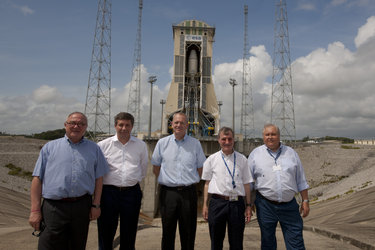Soyuz
In 2011, a Soyuz launcher took off from Europe’s Spaceport in French Guiana. This was an historic event as it was the first time that a Soyuz launcher lifted off from a spaceport other than Baikonur or Plesetsk. It was also a milestone in the strategic cooperation that exists between Europe and Russia in the launcher's sector.
The decision to develop the launch infrastructure to enable Soyuz to be launched from French Guiana was of mutual interest to both Europe and Russia and benefits from funding from the European Community.
Soyuz is a medium-class launcher. Its performance complemented the ESA launchers Ariane and Vega, and enhanced the competitiveness and flexibility of the exploitation of Ariane launchers on the commercial market.
The Soyuz launch vehicle that was used at Europe's Spaceport is the Soyuz-2 version called Soyuz-ST. This included the Fregat upper stage and the ST fairing. Soyuz-2 is a version of the renowned family of Russian launchers that began the space race more than 40 years ago by launching Sputnik, the first satellite to be placed into orbit, and then sending the first man into space – Yuri Gagarin.
Soyuz-2 had improved performance and could place up to 3 tonnes into geostationary transfer orbit, compared to the 1.7 tonnes that could be launched from Baikonur in Kazakhstan.
Soyuz launch site
Geological and topographic surveys began at the site selected for Soyuz at Europe's Spaceport in 2003. The site, called ELS, is located 13 km northwest of the Ariane launch site and consisted of three main zones: the launch platform where the launcher was erected for liftoff; the preparation area (MIK) where the three stages were horizontally assembled and controlled; and the launch control centre.
The MIK was connected to the launch platform by a 700 metre railway which was used to transport the launcher in a horizontal position. The launch control centre is located 1 km from the launch pad.
Human spaceflight
The Soyuz rocket is the workhorse of the Russian human spaceflight missions and has been used for that purpose longer than any other spacecraft. In the 1950s it began transporting cosmonauts into space and then to the Soviet stations Salyout and Mir.
The Soyuz launch infrastructure at Europe's Spaceport was designed so that it could have been smoothly adapted for human spaceflight.















 Germany
Germany
 Austria
Austria
 Belgium
Belgium
 Denmark
Denmark
 Spain
Spain
 Estonia
Estonia
 Finland
Finland
 France
France
 Greece
Greece
 Hungary
Hungary
 Ireland
Ireland
 Italy
Italy
 Luxembourg
Luxembourg
 Norway
Norway
 The Netherlands
The Netherlands
 Poland
Poland
 Portugal
Portugal
 Czechia
Czechia
 Romania
Romania
 United Kingdom
United Kingdom
 Slovenia
Slovenia
 Sweden
Sweden
 Switzerland
Switzerland

































